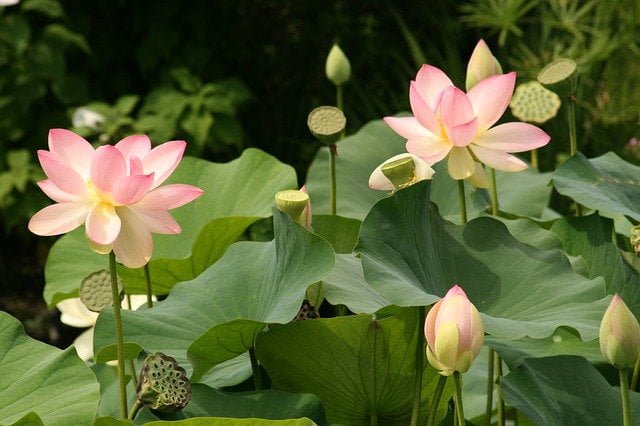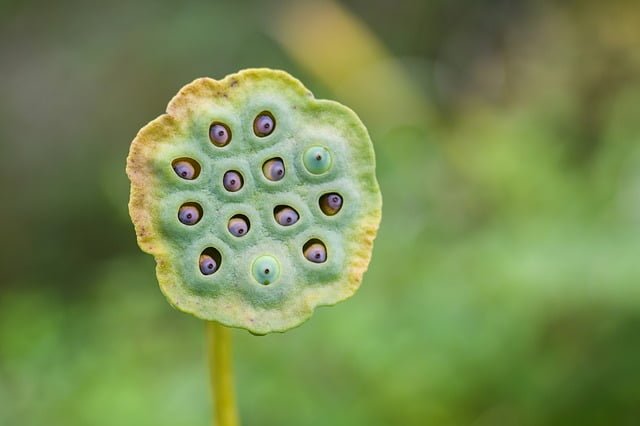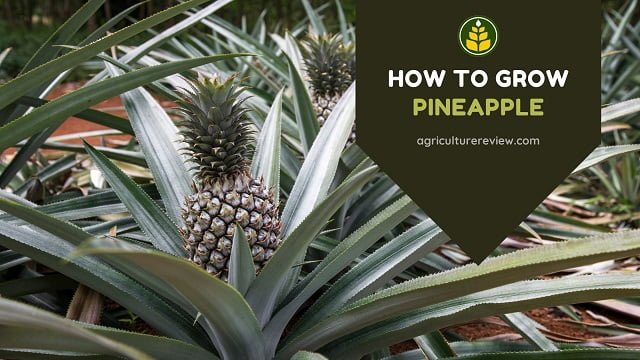A few years ago I decided to start growing lotus in my terrace garden. But, unlike other plants that we generally grow in the soil, lotus grows in the water. Growing lotus was not only about bringing a seed or tuber or a live lotus plant from the market and planting them directly in the soil, but it was something different.
So I started learning, just like you, who is willing to start growing a lotus plant in the garden and is searching for a perfect guide. I tried, and it was a success! In this article I am going to share with you all the important points that you need to take care of while growing a lotus plant. Believe me, growing this beautiful aquatic plant is a lot of fun. Once you learn, growing lotus will feel easier than growing any other plant.
Table of Contents
Introduction
Sacred Lotus or Indian Lotus or Nelumbo nucifera is a species of herbaceous perennial flowering aquatic plant. It is native to central and northern India. Lotus is also the national flower of India and Vietnam. Depending on the variety lotus can grow up to 8 to 12 inches to 6 feet in height.
Along with its beauty lotus has many benefits and uses. The seeds can be used to make herbal oils and medicines. Leaves, flowers, and roots can be used in garnishing. In many parts of the world people use rhizome of lotus as a vegetable.
However, lotus is very invasive! So once you start growing lotus then it will spread very fast. Let’s now learn about growing lotus!
How To Grow Lotus?

Hey, I know that you are thinking that growing lotus is a very tough job. But, believe me growing lotus is very easy only if you know how to grow? And I am going to provide you all the necessary details that you need to know about growing this plant through this article
Step by step you will know about growing season, potting mix, selection of pot, propagation methods to grow your lotus plant.
Growing Season
You can grow lotus in plant hardiness zones 4, 5, 6, 7, 8, 9, 10, and 11 very easily. It can survive in temperate as well as tropical to sub-tropical regions. But, lotus plant do not grow well extreme cold or heat. The most common mistake people make is to try growing lotus during winters. In winter, the lotus plant goes into dormancy; hence it is not a perfect time to grow lotus.
It can thrive well in areas having a temperature range of 20 to 35 degrees Celsius during the summer season. Spring is considered the best season for propagation of the lotus plant.
Potting Mix
Lotus can grow well in a mix of compost and clayey soil. Do not use sandy loam soil or other type of soil mix that you use for growing garden plants. But if compost and clayey soil are not available, then you can use normal garden soil.
The only problem is that the normal soil or loose soil can start floating in water. Mix 80% clayey soil + 20% organic compost like vermicompost to prepare potting mix for growing lotus.
Selection of Pot
For planting lotus, you need to have a container of 18 to 24 inches in diameter and 8 to 12 inches in depth. Fill your container with the potting mix and leave 6 to 8 inch of space at the top. For best results, you can put this container in a water tank. I keep my container in a water tank that is 6 feet in length and 30 inches in depth. However, you can also grow lotus in a single container.
Propagation
You can propagate lotus from seeds, tubers, and rhizomes. But the plant will take nearly one year to flower if you grow lotus from seeds. However, in this article I have discussed propagation of lotus from seeds and tubers.
How to grow lotus from seeds?

To grow lotus from seeds, you can purchase seeds from online stores such as Amazon and Flipkart. Once you have purchased the seed, scrape the pointed end of the seed with the help of a scraping paper or knife.
Once the cream-colored core is visible, then stop scraping. Perform this step very carefully to avoid any damage. After scraping, put the seeds in a transparent bowl or any container and fill it with water. Make sure that the temperature of the water is around 24 to 27 degrees Celsius.
Keep it indoors, and check on the next day for floating seeds in the water. Remove the floating seeds from the water and leave the sunken seeds in the container. Floating seeds are infertile and will not germinate.
Keep changing the water in the container daily. Seeds will start sprouting within 7 to 10 days. Once the seeds have sprouted, then change the water very carefully on a daily basis. When your seedlings reach 6 inches in height and have developed one to two small leaves, then you can start transplanting.
How to grow lotus from tuber?
To grow lotus from a tuber, during the spring season, purchase it from the nearest plant nursery or from online stores. Once you have gotten the tubers, then it’s showtime.
After having a lotus tuber, do not directly sow it in the soil. But start by preparing a fungicide-water solution. In a 20-liter bucket filled with water, add a teaspoon of SAAF Fungicide powder, mix it well, then put the tuber in the solution and leave it for 2 to 4 hours. Take tubers from the bucket and fill the container with water. Put lotus tubers in the water and leave them for 3 to 5 days.
You will notice new root hairs developing from the tubers. At this stage, take your lotus tubers out from the water and fill the container with prepared potting mix. Plant your tubers at the corner of the container and keep the new leaves potion upwards. After planting, you can keep one to two lightweight stones over the tuber so they don’t start floating. Fill the container with water so that your tubers get submerged properly.
Make sure to add water daily if old water evaporates; also, keep removing any algae or fungal growth in the water. Once new leaves start growing, you can fill the water in the container accordingly. Within a month or two you will notice new lotus buds arising.
Transplantation
If you have germinated seeds of lotus then you will need to transplant it. Gardeners often do this mistake of transplanting lotus seedlings at a very early stage. Once you notice growth of one to two leaves in seedlings then you can start transplanting.
Fill the small container with potting mix and place the germinated seeds on the soil. Cover the seed with the an inch layer of soil and put some small stones around the base. Submerge this pot in the water tub carefully.
After submerging, place the leaves on the surface of water and branches should remain in water. Keep your tub under semi shade till your plant get well established. After 2 to 3 days you can move the tub under direct sunlight.
If your tub is large and you can not move it easily then you can perform this process under direct sunlight too. After transplantation, you do not need to change the water daily.
You will also love reading these,
READ MORE: LEARN TO GROW WATER LILY FROM NILIMA
READ MORE: WAYS TO SAVE YOUR PLANTS FROM ANTS
Lotus Plant Care

Once you have successfully grown the sacred lotus plant then you need to know about few important points such as sunlight, water temperature, fertilizers, pruning, pest and diseases, etc. Knowing about these important points will help you to care for your plant very well.
Sunlight
Lotus plant loves bright direct sunlight to grow and flower. Place the lotus tub in an area that receives at least 5 to 6 hours of direct sunlight daily. Sunlight helps in vegetative growth of the plant.
Water Temperature & pH
Water temperature is the another factor that have effects on the growth of the plant. Make sure that the water temperature remains a little warmer. The ideal temperature range of water for growing lotus is 21 to 32 degrees Celsius.
If you are living in colder or temperate regions where standing water can freeze then you can use automatic electric water heater. This is the same one as we use in aquariums. You can set the temperature and relax.
Water should not be alkaline for growing lotus. Water having a neutral pH of 6.0 to 7.0 is good for growing lotus plant.
Fertilizers
Well most of the gardeners start getting confused in fertilizing aquatic plants like lotus. But it is not a tough job. You can fertilize your aquatic plant with pond tablets or liquid fertilizers. I recommend you to purchase pond tablets.
A small lotus plant will need two tablets after every 30 days, while the bigger one will do good with 3 to 4 tablets. But, stop fertilizing your lotus plant from July to the beginning of spring season. As the plant have to prepare for dormancy in winters.
You can start fertilizing your plant once it has reached 6 to 8 leaved stage. To fertilize push the tablets deep in the soil with the help of a tool or your hands.
Pruning
Pruning is a necessary step for caring for your lotus plant. Keep pruning dead or yellowing leaves, branches, and flowers time to time to maintain health of your plant. Lotus is an invasive plant and will spread in the tub or pond very fast.
To maintain the good growth keep pruning the new growths as required. This will help to maintain the proper size of the plant.
Pest and Diseases
Just like other garden plants lotus can also get affected from pest and diseases. Some of the common pest of lotus are aphids, caterpillars, white flies, spider mites, leaf miners, etc can damage your plant.
Do not ever use liquid pesticides whether it is organic or inorganic to control pest on lotus plant. Liquid pesticides can damage this plant. Purchased any powdery pesticide that is good for aquatic plants to control pest in lotus.
Water Depth
During spring season keep the smaller pot at least 2 inches deep in water. But, during fall increase the depth a little bit according to the growth in the length of the branches. This is mainly recommended for places that receives chilling cold freezing winters.
However, if you are living in regions where the climate is moderate then you do not need to worry about the depth much. Just keep the pot submerged at least 2 to 4 inches deep in the water.
Author’s Note
I hope that you will get benefited from my article. Do tell me in comments whether you liked the article or not. If you have any query regarding growing lotus then you can comment below. Or you can connect with Agriculture Review on my Facebook and Instagram page.


